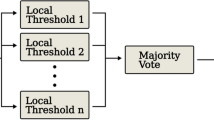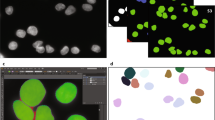Abstract
Fluorescent microscopy imaging is a popular and well-established method for biomedical research. However, the large number of images created in each research trial quickly eliminates the possibility of a manual annotation; thus, the need for automatic image annotation is quickly becoming an urgent need. Furthermore, the high clustering indexes and noise observed in these images contribute to a complex issue, which has attracted the attention of the scientific community. In this paper, we present a fully automated method for annotating fluorescent confocal microscopy images in highly complex conditions. The proposed method relies on a multi-layered segmentation and declustering process, which begins with an adaptive segmentation step using a two-level Otsu’s Method. The second layer is comprised of two probabilistic classifiers, responsible for determining how many components may constitute each segmented region. The first of these employs rule-based reasoning grounded on the decreasing harmonic pattern observed in the region area density function, while the second one consists of a Support Vector Machine trained with features derived from the log likelihood ratio function of Gaussian mixture models of each region. Our results indicate that the proposed method is able to perform the identification and annotation process on par with an expert human subject, thus presenting itself a viable alternative to the traditional manual approach.









Similar content being viewed by others
Notes
In order to register a weak DNA signature, this fluorophore must be highly sensitive. Thus, it also registers the cell nuclei’s DNA. Since the cell nuclei can be trivially subtracted through set operations involving the cell channel, we denominated this channel as the cytoplasmic channel.
Note that the 88 % accuracy percentage referred for the SVM classifier refers to the classification of only multi-nucleic regions, as the accuracy ratings for the RBC refer to multi and uni-nucleic regions, giving it a considerable advantage.
References
Begelman G, Gur E, Rivlin E, Rudzsky M, Zalevsky Z (2004) Cell nuclei segmentation using fuzzy logic engine. In: Proceedings IEEE international conference on image processing
Broad Bioimage Benchmark Collection—annotated biological image sets for testing and validation. Available at http://www.broadinstitute.org/bbbc/
Dempster AP, Laird NM, Rubin DB (1977) Maximum likelihood from incomplete data via the EM algorithm. J R Stat Soc Ser B (Methodological) 39(1):1–38
Everitt BS, Hand DJ (1981) Finite mixture distributions. Chapman & Hall, London (ISBN 0-412-22420-8)
Ficarra E, Cataldo SD, Acquaviva A, Macii E (2011) Automated segmentation of cells With IHC membrane staining. IEEE Trans Biomed Eng 58–5:1421–1429
Freeman H (1961) On the encoding of arbitrary geometric configurations. IRE Trans Electron Comput EC-10(2):260–268
Hall M, Eibe F, Holmes G, Pfahringer B, Reutemann P, Witten IH (2009) The WEKA data mining software: an update. SIGKDD Explor 11(1):10–18
Jiang K, Liao Q, Dai S (2003) A novel white blood cell segmentation scheme using scale-space filtering and watershed clustering. In: Proceedings second international conference on machine learning and cybernetics
Kachouie NN, Fieguth P, Ramunas J, Jervis E (2006) Probabilistic model-based cell tracking. Int J Biomed Imaging 2006:1–10
Leal P, Ferro L, Marques M, Romao S, Cruz T, Tomas AM, Castro H, Quelhas P (2012) Automatic assessment of Leishmania infection indexes on in vitro macrophage cell cultures. Image Anal Recognit Lect Notes Comput Sci 7325:432–439
Liao Q, Deng Y (2002) An accurate segmentation method for white blood cell images. In: IEEE international symposium on biomedical, imaging, pp 245–248
Morse BS (2000) Brigham Young University. SH &B, Section 5
Nogueira PA, Teófilo LF (2012) Automatic analysis of Leishmania infected microscopy images via Gaussian mixture models. Advances in artificial intelligence-SBIA, pp 82–91
Nogueira PA, Teófilo LF (2012) A probabilistic approach to organic component detection in Leishmania infected microscopy images. In: Proceedings of the 8th conference on artificial intelligence applications and innovations, pp 1–10
Park J, Keller JM (1997) Fuzzy patch label relaxation in bone marrow cell segmentation. In: IEEE international conference on computational cybernetics and simulation, pp 1133–1138
Platt J (1998) Fast training of support vector machines using sequential minimal optimization. In: Schoelkopf B, Burges C, Smola A (eds) Advances in Kernel methods—support vector learning. MIT Press
Rabiner LR (1989) A tutorial on Hidden Markov Models and selected applications in speech recognition. Proc IEEE 77(2):257–286
Reynolds D (2007) Gaussian mixture models. MIT Lincoln Laboratory, 244 Wood St., Lexington, MA 02140, USA
Sethian J (1999) Level set methods and fast machining methods: evolving interface in computational geometry. Fluid mechanics, computer vision and material science. Cambridge University Press, Cambridge
Spring KR (2010) MicroscopyU: introduction to fluorescence microscopy
Usaj M, Torkar D, Kanduser M, Miklavcic D (2010) Cell counting tool parameters optimization approach for electroporation efficiency determination of attached cells in phase contrast image. J Microsc 241(3):303–314
Yan P, Zhou X, Shah M, Wong STC (2008) Automatic segmentation of high-throughput RNAi fluorescent cellular images. IEEE Trans Inf Technol Biomed 12(1):12–1
Yang F, Mackey MA, Ianzini F, Gallardo G, Sonka M (2005) Cell segmentation, tracking, and mitosis detection using temporal context. MICCAI 2005. LNCS, vol 3749, pp 302–309
Yang X, Li H, Zhou X (2006) Nuclei segmentation using marker-controlled watershed, tracking using mean-shift, and Kalman filter in time-lapse microscopy. IEEE Trans Circuits Syst I Regul Pap 53(11) 2405–2414
Yu W, Lee HK, Hariharan S, Bu W, Ahmed S (2008) Level set segmentation of cellular images based on topological dependence. In: Proceedings of the 4th international symposium on advances in visual computing
Zhou X, Li F, Yan J, Wong STC (2009) A novel cell segmentation method and cell phase identification using Markov models. IEEE Trans Inf Technol Biomed 13(2):1089–7771
Author information
Authors and Affiliations
Corresponding author
Rights and permissions
About this article
Cite this article
Nogueira, P.A., Teófilo, L.F. A multi-layered segmentation method for nucleus detection in highly clustered microscopy imaging: A practical application and validation using human U2OS cytoplasm–nucleus translocation images. Artif Intell Rev 42, 331–346 (2014). https://doi.org/10.1007/s10462-013-9415-x
Published:
Issue Date:
DOI: https://doi.org/10.1007/s10462-013-9415-x




